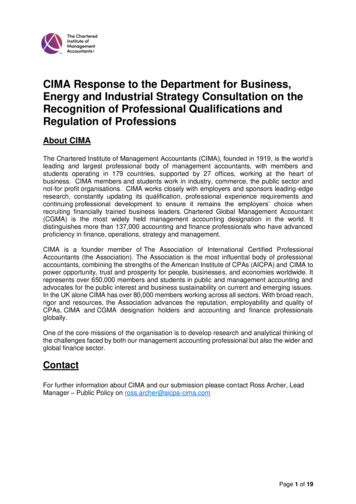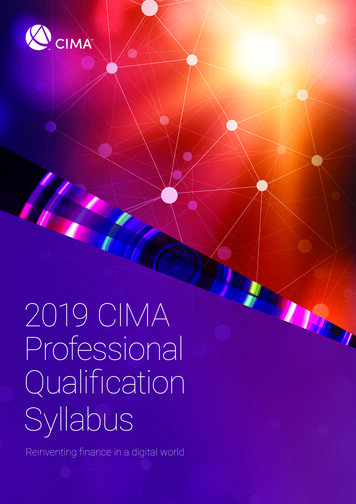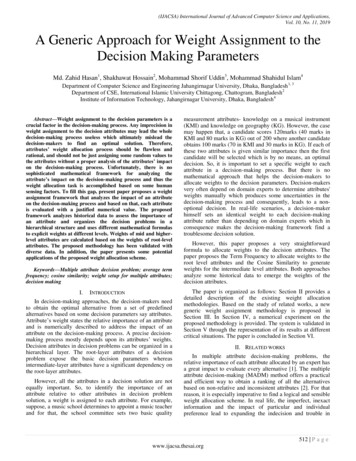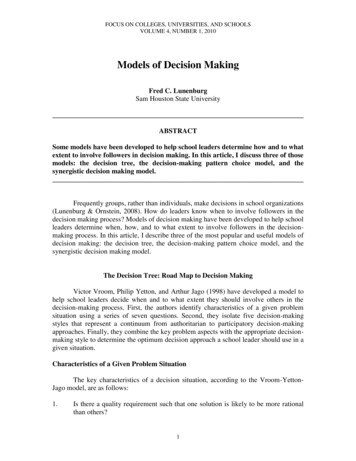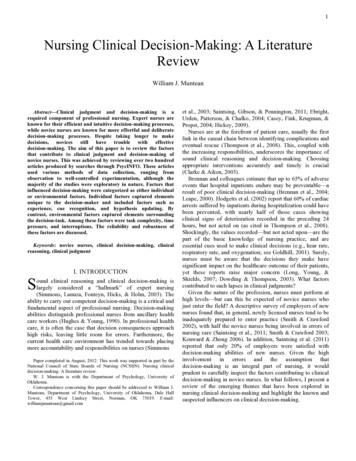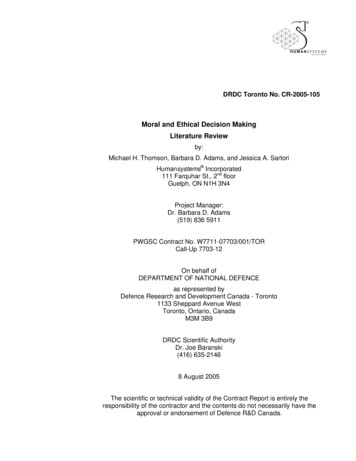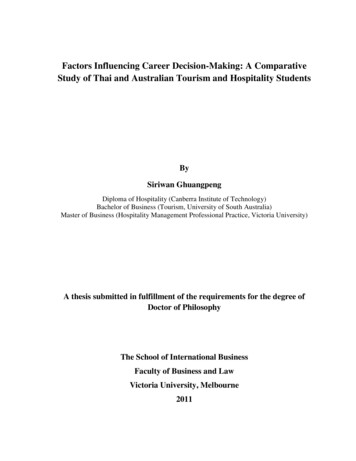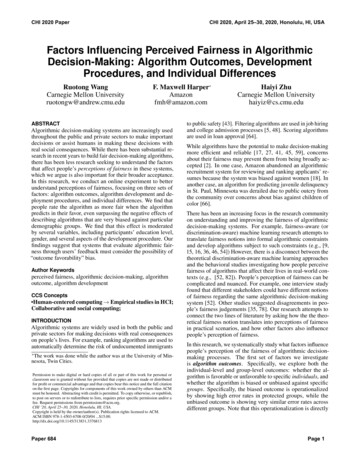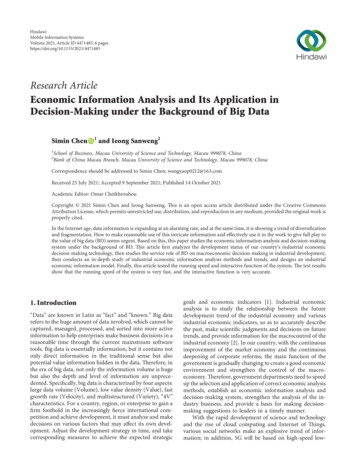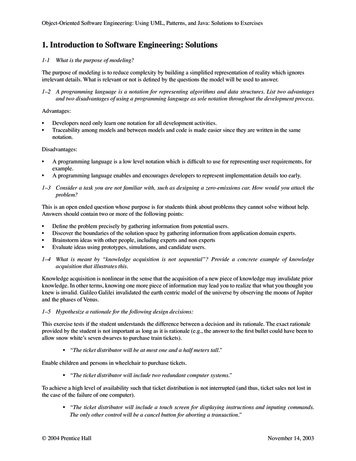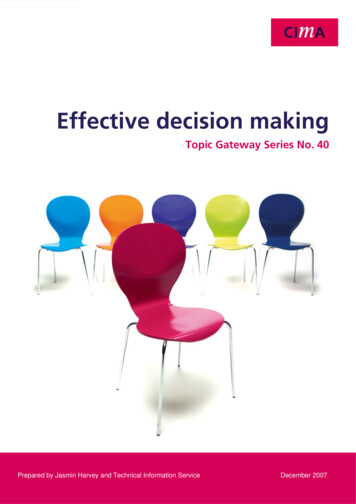
Transcription
Topic Gateway SeriesEffective decision makingEffective decision makingTopic Gateway Series No. 40Prepared by Jasmin Harvey and Technical Information Service1December 2007
Topic Gateway SeriesEffective decision makingAbout Topic GatewaysTopic Gateways are intended as a refresher or introduction to topics of interestto CIMA members. They include a basic definition, a brief overview and a fullerexplanation of practical application. Finally they signpost some further resourcesfor detailed understanding and research.Topic Gateways are available electronically to CIMA members only in the CPDCentre on the CIMA website, along with a number of electronic resources.About the Technical Information ServiceCIMA supports its members and students with its Technical Information Service(TIS) for their work and CPD needs.Our information specialists and accounting specialists work closely together toidentify or create authoritative resources to help members resolve their workrelated information needs. Additionally, our accounting specialists can help CIMAmembers and students with the interpretation of guidance on financial reporting,financial management and performance management, as defined in the CIMAOfficial Terminology 2005 edition.CIMA members and students should sign into My CIMA to access these servicesand resources.The Chartered Instituteof Management Accountants26 Chapter StreetLondon SW1P 4NPUnited KingdomT. 44 (0)20 7663 5441F. 44 (0)20 7663 5442E. tis@cimaglobal.comwww.cimaglobal.com2
Topic Gateway SeriesEffective decision makingEffective decision makingDefinition and conceptOrganisations are constantly making decisions at every level. Decision makingranges from strategic decisions through to managerial decisions and routineoperational decisions. Decision making in business is about selecting choices orcompromises in order to meet business objectives.However, decision making is not just about selecting the right choices orcompromises. ‘Unless a decision has ‘degenerated into work’, it is not a decision.It is at best a good intention’ [Drucker, 1967].Effective decision making is defined here as the process through whichalternatives are selected and then managed through implementation to achievebusiness objectives.‘Effective decisions result from a systematic process, with clearly definedelements, that is handled in a distinct sequence of steps’ [Drucker, 1967].Management accountants have key roles to play throughout the effectivedecision making process.ContextGlobal markets give companies access to similar resources and competitioncauses many business processes to converge on similar standards. Decisionmaking is becoming the remaining basis of competitive advantage that cangenerate superior returns for shareholders.Meanwhile, many leading companies have taken the opportunities presented bydevelopments in systems and globalisation to transform their finance andaccounting (F&A) functions. These opportunities have enabled companies to beboth more efficient in their operations and more effective in how they supportdecision making across the business.Traditionally, the role of the accountant in business may have been to providemanagement information to support decision making or to flex the budget aftera decision had been made to allow implementation. However, the role of themanagement accountant is relevant throughout the process of effective decisionmaking. For a definition of the role of the management accountant, please referto CIMA’s Official Terminology 2005.3
Topic Gateway SeriesEffective decision makingManagement accountants can be engaged to contribute at each stage of theeffective decision making process. They can be involved in: setting the context and framing the issue to be considered performance and risk management during implementation the financial and narrative reporting of outcomes.In the current syllabus, effective decision making is implicit in the entire syllabusof the professional qualification as it is central to the role of the managementaccountant.Students must understand decision making and will be examined on it in Paper 2,Management Accounting Decision Management, Paper 6, ManagementAccounting Business Strategy and Paper 10, the Test of Professional Competencein Management Accounting.In the CIMA Professional Development Framework, decision making is inherent inthe Management Accounting and Strategic Management competences. Decisionmaking features specifically in Business Skills Analysis and Making Decisions.Related conceptsFinance transformation; finance/business partnering; CIMA Strategic Scorecard .OverviewDecision making is becoming the basis of competitive advantage and valuecreation for organisations. Improving decision making could be the key tosuperior business performance if global markets give all organisations access tosimilar resources and competition causes many business processes to convergeon world-class standards. The quality of decision making could become the keydifferentiator and link in the value chain as illustrated below.The importance of decision makingWhy is decision making so important?Source: CIMA, September 20074
Topic Gateway SeriesEffective decision makingMany companies have a formalised strategic planning process and a governanceprocess at board level. However, the planning process can often generate reportsrather than decisions. The board’s role in decision making is often just to overseeor ratify. Usually only routine operational decisions, for example, creditmanagement, have fully documented processes. Many decisions are taken by linemanagement outside formal processes.The decision making process can be illustrated as a proposal considered bydecision makers in the context of the organisation and its strategic position.Alternatives, risks and potential outcomes are considered and then a decision isreached. There may also be a post audit and a feedback loop. The decisionmaking process is subject to human error as the decision makers havepersonalities, prejudices and a self-interest bias. Importantly, they have differentattitudes to and appetites for risk.There is an opportunity here for management accountants to improve decisionmaking through their role as finance/business partners. Finance must be able toprovide timely and accurate management information to achieve impact.However, an effective decision making process and increased shareholder valuealso depend on finance to: communicate this information effectively have an understanding of its relevance to the business share insights influence the decision manage the performance and risk effectively.Improving decision making5
Topic Gateway SeriesEffective decision makingApplicationEffective decisions result from a systematic processEffective decision making can be achieved by following a step-by-step process.In reality, this process is unlikely to be documented or followed systematically.However, when the CIMA Improving Decision Making in Organisations Forumconsidered the steps implicit in an effective decision making process, it becameclear that the management accountant has a key role to play in improvingdecision making (see Overview).The decision making process and the work of the charteredmanagement accountantAn effective decision making process includes the following steps:6
Topic Gateway SeriesEffective decision makingEnterprise GovernanceThe board provides the overall enterprise governance of the organisation. Thismeans that it exercises effective oversight of both the conformance andperformance aspects of the organisation. The formal planning process providesthe strategic context, brand values and budgetary constraints in which decisionsare made.Enterprise Governance is represented by the CIMA Strategic Scorecard toillustrate the overall governance context in which strategic decisions are taken.The CIMA Strategic Scorecard is a tool developed by CIMA to help the boardof any organisation to engage effectively in the strategic process. For moreinformation, refer to the CIMA Strategic Scorecard topic gateway.Context/mindsetDecisions are taken in the general context of the organisation’s overall strategicdirection, ethics and culture by individuals with their own prejudices andattitudes in the context of the issue being considered. The potential impact ofprejudice in the organisational culture and people’s attitudes and behaviourcannot be underestimated. Management accountants can help to ensure thatalternatives are considered properly and decision making is evidence based.Frame the issueThis is a key step. Issues must be properly framed to balance a broad view withefficient focus. Appropriate parties must be engaged. Stakeholders’ interests aretaken into account in determining the objectives at this stage. In businesses thatare managed for value, the main criterion will be the impact on shareholdervalue.Assemble informationThis involves the provision of insightful information to describe the business’scurrent financial and competitive position. Information is also assembled for abusiness proposal(s), the value for customers and the impact on theorganisation’s value chain. The risks involved require close co-operation orpartnering with the business.7
Topic Gateway SeriesEffective decision makingSelect alternativesAlternatives should be selected on the basis of evidence and analysis rather thanpersonal opinions. Risks must be identified as either ‘deal-breakers’ or issues tobe managed. Management accountants can facilitate unbiased, evidence baseddecision making. They can provide consistent quantitative and qualitative analysisof the situation and proposals.DecisionsThe decision maker(s) should have the authority to take the decision. Role clarityand understanding is important here so that decisions are reached efficiently andnot delayed or swayed by other interested parties.Manage implementation and impactManaging implementation through to impact requires that the decision shouldbe clearly communicated and the expected outcomes reflected in performancemanagement metrics. Quantifying or describing potential outcomes and, ifappropriate, the potential next steps after each outcome, will enableimplementation to be managed and appropriate action taken promptly. This willensure that goals are achieved.FeedbackTrial and error may be allowed as tactical experiments within acceptable riskparameters, but repeating past mistakes should be inexcusable. The decision andmatters considered should be properly documented for post audit or learningpurposes. The outcome of past decisions should be captured as part of thecorporate memory to ensure that lessons are learned.The role of the management accountantFor decision making to be effective, management accountants must becomefinance/business partners. In order for this to happen, the finance and accountingpartners must overcome the following challenges.1. To provide useful management information more efficiently.2. To work closely with the business to combine their financial expertise withthe business’ expertise to help achieve impact.8
Topic Gateway SeriesEffective decision makingFinance/business partners can apply financial disciplines such as managing forvalue, performance management, risk management or analytics to support thebusiness to make more effective decisions. However, this is not just aboutsupplying financial information, or a performance measure orother management information but it is about: sharing insights based on an understanding of the value drivers in thebusiness challenging views and assumptions constructively using intuitive logic to provide an opinion providing metrics and analysis to support evidence based decision making managing performance and risk through to achieving impact.Key developments in effective decision makingOver recent years, many leading organisations have transformed their F&Afunctions so that they support the business and improve decision making. Thesefunctions have the people, systems, processes and structure to provide timely andaccurate financial and management information in a user friendly format. Theirfinance people are business literate as well as financial experts. They operatewithin a culture that values their contribution to evidence based decision making.The first step in a change programme to improve managerial decision makingshould be determining a shared vision for the F&A function’s role. This sharedvision should be developed and communicated by the CEO and CFO to the widerbusiness so that it is expected that finance/business partners will improve decisionmaking. A change agenda should look at both the efficiency and effectiveness ofthe F&A’s vision, people, systems, processes and structure.Case studies/examplesCIMA’s Executive Report, Improving decision making in organisations: theopportunity to transform finance, provides case studies, examples andexperiences from leading organisations.ReferenceImproving decision making in organisations: the opportunity to transformfinance. (PDF 1.22MB). September 2007. CIMA Executive Report. London: CIMA.Available from: www.cimaglobal.com/executivereports[Accessed 6 February 2008]9
Topic Gateway SeriesEffective decision makingDrucker, P. F. The effective decision. Harvard Business Review, January/February1967, Volume 45, Issue 1, pp 92-98Janczak, S. The strategic decision-making process in organizations. Problems andPerspectives in Management, Issue 3, 2005, pp 58-70Further informationCIMA ArticlesGrundy, T. Strategic decision making. (PDF 1600KB). Financial Management,October 2005, pp 26-27, 2 p. Available ed 6 February 2008]Murby, L. Making your balanced scorecard work harder. CIMA Insight, June2005. Available from: www.cimaglobal.com/insight[Accessed 6 February 2008]Thambar, P. CFOs admit finance does not partner business effectively. CIMAInsight, August 2006. Available from: www.cimaglobal.com/insight[Accessed 6 February 2008]One2One: Andrew Higginson, Finance and Strategy Director, Tesco. ’FinancialManagement, (PDF 330KB). March 2005, pp 6-8, 3 p. Available ed 6 February 2008]CIMA publicationsBacon, N. and Berry, B. Pursuing shareholder value: implications for humanresource management. (PDF 64KB). May 2004. CIMA Research ExecutiveSummary. London: CIMA. Available ssed 7 February 2008]Collier, P., Berry, A. and Burke, G. Risk and management accounting: bestpractice guidelines for enterprise-wide internal control procedures. CIMAResearch Executive Summaries Series, May 2006, Volume 2, No. 11. Availablefrom: www.cimaglobal.com/researchexecsummaries[Accessed 7 February 2008]Cooper, S. et al. (2001). Shareholder or stakeholder value. London: CIMAPublishing10
Topic Gateway SeriesEffective decision makingEdwards, J., Collier, P. and Shaw, D. Knowledge management and its impact onthe management accountant. (PDF 37KB). CIMA Research Executive SummariesSeries, July 2005, Vol. 1, No. 9. Available ssed 7 February 2008]Ezzamel, M., Morris, J. and Smith, J. Accounting for new organisational forms:the case of subcontracting and outsourcing. (PDF 79KB). CIMA ResearchExecutive Summaries Series, April 2006, Volume 2, No. 3. Available ssed 7 February 2008]Fahy, M. and Fuller, C. (2007). Wheels of change: business process outsourcing.Excellence in Leadership Series, No. 1. London: CIMA PublishingGould, S. Improving decision making in your organisation: the CIMA StrategicEnterprise Management (SEM) initiative. (PDF 1075KB). CIMA Executive Report.CIMA: London. Available from: www.cimaglobal.com/executivereports[Accessed 7 February 2008]Northcott, D. and Llewellyn, S. Decision making in healthcare: exploring costvariability. (PDF 48KB). CIMA Research Executive Summaries Series, November2004, Volume 1, No. 2. Available ssed 7 February 2008]Starovic, D., Cooper, S. and Davis, M. Maximising shareholder value: achievingclarity in decision making. (PDF 162KB). CIMA Technical Report, January 2005.Available from: www.cimaglobal.com/technicalreports [Accessed 7 February2008]Starovic, D. and Marr, B. Understanding corporate value: managing andreporting intellectual capital. (PDF 128KB). CIMA Technical Report, June 2003.London: CIMA. Available from: www.cimaglobal.com/technicalreports[Accessed 7 February 2008]Improving decision making in organisations: the opportunity to transformfinance. (PDF 1.22MB). September 2007. CIMA Executive Report. London: CIMA.Available from: www.cimaglobal.com/executivereports[Accessed 7 February 2008]11
Topic Gateway SeriesEffective decision makingThe CIMA Strategic Scorecard : boards engaging in strategy. (PDF 503KB).CIMA Executive Report, April 2007. London: CIMA. Available from:www.cimaglobal.com/executivereports[Accessed 7 February 2008]Latest trends in corporate performance measurement. CIMA Technical Briefing,July 2002. London: CIMACIMA (2006). The future of the finance function: a view from the top. CIMAwebcastCIMA Technical Services. Data warehousing: its role in improved organisationaldecision making. (PDF 269KB). CIMA Technical Report, February 2003. London:CIMA. Available from: www.cimaglobal.com/technicalreports[Accessed 7 February 2008]CIMA/AICPA and CMA Canada. (2007). Outsourcing the Finance and AccountingFunctions. Management Accounting Guideline. Canada: The Society ofManagement Accountants of Canada. (CMACanada). Available from:www.cimaglobal.com/mags[Accessed 14 March 2008]CIMA/AICPA and CMA Canada. (2005). Identifying, measuring and managingorganisational risk for improved performance. Management AccountingGuideline. Canada: The Society of Management Accountants of Canada.(CMA-Canada). Available from: www.cimaglobal.com/mags[Accessed 14 March 2008]IFAC/CIMA. February 2004. Enterprise Governance – getting the balance right.(PDF 733KB). CIMA Executive Report. Available from:www.cimaglobal.com/executivereports[Accessed 7 February 2008](2005). CIMA Official Terminology. London: CIMA PublishingOther articles and publicationsBeasley, M. et al. Working hand-in-hand: balanced scorecards and enterprise riskmanagement. Strategic Finance, March 2006, Volume 87, Issue 9, pp 49-55Published by the Institute of Management Accountants. www.imanet.org[Accessed 7 February 2008]Bekefi, T. and Epstein, M.J. (2006). Integrating social and political risks intobusiness decisions, Management Accounting Guideline. Canada: The Society ofManagement Accountants of Canada. (CMACanada)12
Topic Gateway SeriesEffective decision makingDavenport, T. H. The coming commoditization of processes. Harvard BusinessReview, June 2005, Volume 83, Issue 6, pp 100-108Epstein, M.J and Rejc, A. (2006). The reporting of organisational risks for internaland external decision makers. Management Accounting Guideline. Canada: TheSociety of Management Accountants of Canada. (CMA-Canada)Ittner, C. D. and Larcker, D. F. Coming up short on non-financial performance.Harvard Business Review, November 2003, Volume 81, Issue 11, pp 88-95Likierman, A. Prove your worth. Accountancy Age, 19 January 2006www.accountancyage.com[Accessed 7 February 2008]Mankins, M. C. Stop wasting valuable time. Harvard Business Review, September2004, Volume 82, Issue 9, pp 58-65Mankins, M. C. and Steele, R. Stop making plans, start making decisions. HarvardBusiness Review, January 2006, Volume 84, Issue 1, pp 76-84Martin, R. How successful leaders think. Harvard Business Review, June 2007,Volume 85, Issue 6, pp 60-67Rappaport, A. 10 ways to create shareholder value. Harvard Business Review,September 2006, Volume 84, Issue 9, pp 66-77Rayner, N. (2006). CFO finance system priorities through 2009. Gartner Inc.www.gartner.com[Accessed 7 February 2008]Thomas, M. (2003) Value-based strategy: you can’t leap to greatness – takesensible steps. Viewpoint on managing for shareholder value, PA ConsultingGroup www.paconsulting.com[Accessed 7 February 2008]Useem, M. How well-run boards make decisions. Harvard Business Review,September 2006, Volume 84, Issue 11, pp 130-138Williams, K. Finance transformation: making progress. Strategic Finance,November 2003, Vol. 85, Issue 5, pp 17-21, 2 p. Published by the Institute ofManagement Accountants. www.imanet.org[Accessed 7 February 2008]The Economist Intelligence Unit. (2006). Being the best: insights from leadingfinance functions. KPMG LLP (UK) www.kpmg.com[Accessed 7 February 2008]13
Topic Gateway SeriesEffective decision makingEquaTerra. (2007). EquaTerra Advisor and BPO/ITO Service Provider Pulse SurveyResults 2nd Quarter 2007. www.equaterra.com[Accessed 7 February 2008]IBM Business Consulting Services. (2005). The agile CFO: acting on businessinsightKPMG Management Consulting. (1998). Finance of the future: a guide forbusiness users. KPMG LLP (UK) www.kpmg.com[Accessed 7 February 2008](2007). Management information and performance: CFOs face new demand forhigh-quality data that drives decisions. PriceWaterhouseCoopers www.pwc.com[Accessed 7 February 2008](2007). The Reforecasting Report: 2006 survey of current practices in the UK.BusinessObjects www.businessobjects.com[Accessed 7 February 2008](2006). Mastering finance challenges to achieve high performance, insights intofinance and performance management mastery. Accenturewww.accenture.com[Accessed 7 February 2008](2004). Finance and performance management mastery and the high performingbusiness. Accenture www.accenture.com[Accessed 7 February 2008]CIMA MastercoursesPerformance management. To book via www.cimamastercourses.com pleasego to Find and key in the course code ATBP.[Accessed 7 February 2008]Performance measurement and benchmarking. To bookvia www.cimamastercourses.com please go to Find and key in the course codePMCI. [Accessed 7 February 2008]Enterprise risk management. To book via www.cimamastercourses.com pleasego to Find and key in the course code ENRM.[Accessed 7 February 2008]14
Topic Gateway SeriesEffective decision makingCIMA reading listsAvailable to CIMA members only via My CIMAwww.cimaglobal.com/mycima[Accessed 7 February 2008]Contracting out the finance functionEnterprise risk managementFuture of financePerformance measurement and managementWebsitesThe Foundation for Performance MeasurementThis website has a number of resources on performance management.www.fpm.com[Accessed 7 February 2008]Stern StewartA consulting firm that specialises in the measurement and creation ofshareholder wealth. www.sternstewart.com[Accessed 7 February 2008]The Hackett GroupA global strategic advisory firm in business transformation andassociated services. The website has a number of resources and casestudies on areas such as risk, performance management, businessprocesses, etc. www.thehackettgroup.com[Accessed 7 February 2008]First published in 2007 by:No responsibility for loss occasioned to any person acting or refraining fromaction as a result of any material in this publication can be accepted by theauthors or the publishers.The Chartered Institute ofManagement Accountants26 Chapter StreetLondon SW1P 4NPUnited KingdomAll rights reserved. No part of this publication may be reproduced, storedin a retrieval system, or transmitted, in any form or by any means methodor device, electronic (whether now or hereafter known or developed),mechanical, photocopying, recorded or otherwise, without the prior15permission of the publishers.Printed in Great BritainPermission requests should be submitted to CIMA at tis@cimaglobal.comCopyright CIMA 2007
management information to support decision making or to flex the budget after a decision had been made to allow implementation. However, the role of the management accountant is relevant throughout the process of effective decision making. For a definition of the role of the management accountant, please refer to . CIMA's Official Terminology .
